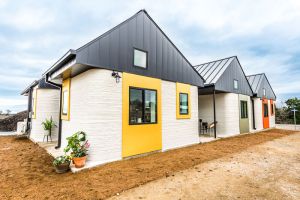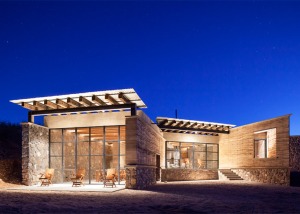 With the global housing deficit looming as a monumental challenge, the emergence of 3D printing technology in construction offers a beacon of hope. From the United Arab Republic to the heartland of the United States, innovative companies are harnessing the power of 3D printing to revolutionize housing projects, promising faster construction times and reduced costs. This transformative technology has captured the imagination of affordable housing advocates worldwide, presenting a potential game-changer in addressing the housing crisis. However, the realization of its full potential hinges on overcoming various hurdles, from regulatory adaptations to investment in infrastructure and reimagining the housing value chain. As we embark on this journey toward sustainable and inclusive housing solutions, it becomes evident that 3D printing is just the tip of the iceberg in the broader innovation required to tackle this pressing global issue. Continue reading
With the global housing deficit looming as a monumental challenge, the emergence of 3D printing technology in construction offers a beacon of hope. From the United Arab Republic to the heartland of the United States, innovative companies are harnessing the power of 3D printing to revolutionize housing projects, promising faster construction times and reduced costs. This transformative technology has captured the imagination of affordable housing advocates worldwide, presenting a potential game-changer in addressing the housing crisis. However, the realization of its full potential hinges on overcoming various hurdles, from regulatory adaptations to investment in infrastructure and reimagining the housing value chain. As we embark on this journey toward sustainable and inclusive housing solutions, it becomes evident that 3D printing is just the tip of the iceberg in the broader innovation required to tackle this pressing global issue. Continue reading
Tag Archives: sustainable building practice
What is Rammed Earth Construction?
 In an age where sustainability and environmental consciousness are at the forefront of architectural innovation, ancient building techniques are experiencing a renaissance. Among these age-old methods, rammed-earth construction stands out as a beacon of eco-friendly building practices. Modern rammed-earth technology combines traditional wisdom with contemporary engineering, offering a sustainable solution to contemporary construction challenges. In this article, we delve into the intricacies of modern rammed-earth technology, examining its process, characteristics, environmental benefits, as well as its advantages and disadvantages. Continue reading
In an age where sustainability and environmental consciousness are at the forefront of architectural innovation, ancient building techniques are experiencing a renaissance. Among these age-old methods, rammed-earth construction stands out as a beacon of eco-friendly building practices. Modern rammed-earth technology combines traditional wisdom with contemporary engineering, offering a sustainable solution to contemporary construction challenges. In this article, we delve into the intricacies of modern rammed-earth technology, examining its process, characteristics, environmental benefits, as well as its advantages and disadvantages. Continue reading
Air Sealing: Enhancing Energy Efficiency & Thermal Comfort in New Homes
 As homeowners and builders increasingly prioritize energy efficiency and thermal comfort, advanced air sealing techniques have emerged as a crucial aspect of modern construction and retrofitting projects. Proper air sealing not only reduces energy consumption and utility costs but also enhances indoor air quality and overall comfort levels. In this article, we’ll explore the latest innovations in air sealing technologies and techniques that homeowners and builders can implement to achieve superior energy efficiency and thermal comfort in residential properties. Continue reading
As homeowners and builders increasingly prioritize energy efficiency and thermal comfort, advanced air sealing techniques have emerged as a crucial aspect of modern construction and retrofitting projects. Proper air sealing not only reduces energy consumption and utility costs but also enhances indoor air quality and overall comfort levels. In this article, we’ll explore the latest innovations in air sealing technologies and techniques that homeowners and builders can implement to achieve superior energy efficiency and thermal comfort in residential properties. Continue reading
Intro to ICFs and Alternative ICFs
 Insulating concrete form or insulated concrete form (ICF) is a system of formwork for reinforced concrete usually made with a rigid thermal insulation that stays in place as a permanent interior and exterior substrate for walls, floors, and roofs. The forms are interlocking modular units that are dry-stacked (without mortar) and filled with concrete. The units lock together somewhat like Lego bricks and create a form for the structural walls or floors of a building. ICF construction has become commonplace for both low rise commercial and high performance residential construction as more stringent energy efficiency and natural disaster resistant building codes are adopted. Continue reading
Insulating concrete form or insulated concrete form (ICF) is a system of formwork for reinforced concrete usually made with a rigid thermal insulation that stays in place as a permanent interior and exterior substrate for walls, floors, and roofs. The forms are interlocking modular units that are dry-stacked (without mortar) and filled with concrete. The units lock together somewhat like Lego bricks and create a form for the structural walls or floors of a building. ICF construction has become commonplace for both low rise commercial and high performance residential construction as more stringent energy efficiency and natural disaster resistant building codes are adopted. Continue reading
Advanced Framing (Optimum Value Engineering)
 In an era when sustainability, cost-efficiency, and resource conservation are paramount concerns in the construction industry, Advanced Framing, also known as Optimum Value Engineering (OVE), has emerged as a revolutionary construction method. Advanced Framing is not just a building technique; it’s a comprehensive approach to design and construction that rethinks traditional practices to maximize energy efficiency, minimize waste, and reduce construction costs. This article delves into the world of Advanced Framing, exploring its principles, benefits, challenges, and the role it plays in shaping the future of sustainable and cost-efficient building. Continue reading
In an era when sustainability, cost-efficiency, and resource conservation are paramount concerns in the construction industry, Advanced Framing, also known as Optimum Value Engineering (OVE), has emerged as a revolutionary construction method. Advanced Framing is not just a building technique; it’s a comprehensive approach to design and construction that rethinks traditional practices to maximize energy efficiency, minimize waste, and reduce construction costs. This article delves into the world of Advanced Framing, exploring its principles, benefits, challenges, and the role it plays in shaping the future of sustainable and cost-efficient building. Continue reading
Cutting-Edge Innovations in Wood-Frame Construction
 Wood has been a staple material in construction for centuries, offering natural beauty, sustainability, and versatility. Over the years, wood-frame construction has witnessed significant innovations that have revolutionized the way we build structures. These innovations not only enhance the structural integrity and safety of wooden buildings but also contribute to sustainability and energy efficiency. In this article, we will delve into 12 cutting-edge innovations that are shaping the future of wood-frame construction. Continue reading
Wood has been a staple material in construction for centuries, offering natural beauty, sustainability, and versatility. Over the years, wood-frame construction has witnessed significant innovations that have revolutionized the way we build structures. These innovations not only enhance the structural integrity and safety of wooden buildings but also contribute to sustainability and energy efficiency. In this article, we will delve into 12 cutting-edge innovations that are shaping the future of wood-frame construction. Continue reading
12 Features of the Eco-friendly Home
 An eco-friendly home is designed to minimize our negative impacts on the environment such as global warming, pollution, and depletion of natural resources. It is built with materials and technologies that promote energy efficiency, water conservation, and waste reduction. In this article, we will explore twelve features of an eco-friendly home that can help reduce our carbon footprint and promote sustainable living. Continue reading
An eco-friendly home is designed to minimize our negative impacts on the environment such as global warming, pollution, and depletion of natural resources. It is built with materials and technologies that promote energy efficiency, water conservation, and waste reduction. In this article, we will explore twelve features of an eco-friendly home that can help reduce our carbon footprint and promote sustainable living. Continue reading
What is a Rainscreen?
 A rainscreen is a type of wall system that has been designed to manage moisture and prevent water from penetrating into the building envelope. The term “rainscreen” describes the way that the system works: rainwater is kept away from the wall’s structural components, while an air gap provides ventilation and allows moisture to evaporate. Continue reading
A rainscreen is a type of wall system that has been designed to manage moisture and prevent water from penetrating into the building envelope. The term “rainscreen” describes the way that the system works: rainwater is kept away from the wall’s structural components, while an air gap provides ventilation and allows moisture to evaporate. Continue reading
What is Low-Carbon Concrete?
 The active ingredient in concrete is cement, and concrete’s ubiquitous usage makes cement the most widely used industrial commodity today. The world consumes about half a ton of cement per person per year. But alongside its positive benefits as a construction material, cement also puts a major strain on the environment. Cement production currently accounts for 3% of world energy consumption and roughly 8% of global greenhouse gas emissions. Reducing emissions from the cement sector is critical to meeting the United Nation’s goal of limiting global warming to 1.5°C, but the sector has proven inherently challenging to decarbonize. This challenge is prompting a major drive to develop technological solutions that can address these processing emissions, including significant upticks in both investments and startup activity in low-carbon cement. Continue reading
The active ingredient in concrete is cement, and concrete’s ubiquitous usage makes cement the most widely used industrial commodity today. The world consumes about half a ton of cement per person per year. But alongside its positive benefits as a construction material, cement also puts a major strain on the environment. Cement production currently accounts for 3% of world energy consumption and roughly 8% of global greenhouse gas emissions. Reducing emissions from the cement sector is critical to meeting the United Nation’s goal of limiting global warming to 1.5°C, but the sector has proven inherently challenging to decarbonize. This challenge is prompting a major drive to develop technological solutions that can address these processing emissions, including significant upticks in both investments and startup activity in low-carbon cement. Continue reading
Everything You Need to Know about Shipping Container Homes
 Shipping containers fill a crucial niche in the world’s economy. They are large and sturdy enough to uniformly transport goods but small enough to fit on trucks and light enough to be moved by cranes and forklifts. However, over the decades a challenge emerged: an excess of used containers. Where some saw a problem, innovative architects see an eco-friendly opportunity. Continue reading
Shipping containers fill a crucial niche in the world’s economy. They are large and sturdy enough to uniformly transport goods but small enough to fit on trucks and light enough to be moved by cranes and forklifts. However, over the decades a challenge emerged: an excess of used containers. Where some saw a problem, innovative architects see an eco-friendly opportunity. Continue reading
